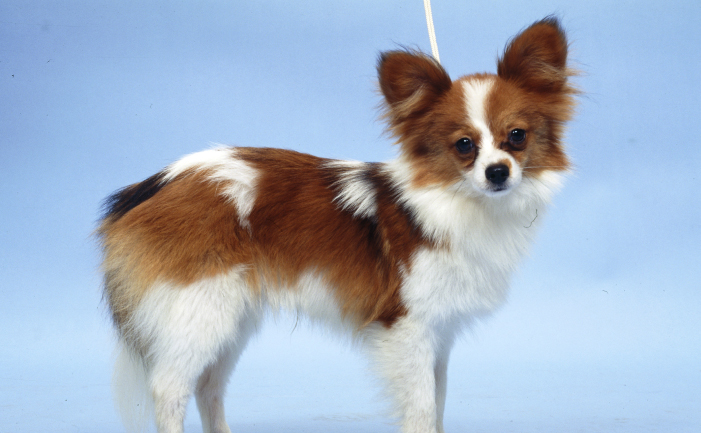Breed: Papillon dog
Temperament: lively, affectionate
Lifespan: 13-14 years
Maintenance: medium
Recommended for: elderly, units, those who want companionship
History
Marie Antoinette, the last queen of France, was said to have carried her cherished Papillons to the guillotine during the French Revolution. Luckily enough for the Papillons, they were spared the same fate as their owner.
Throughout Europe, exact origins are mere conjecture; with dwarf spaniel, miniature bichon and spitz-types all thought to have contributed. Regardless of its origins, the Papillon was once a very popular breed amongst the aristocracy of continental Europe and paintings depicting these toy dogs sitting in the laps of their owners date back as early as the 16th century.
Papillon is French for butterfly, a name given because the stripe down its face combined with its large ears gives the impression of a butterfly’s body.
A second, and less often seen variety is called the Phalene, the French word for moth. Phalenes simply have dropped ears, hence the distinction between the butterfly and moth.
The first Papillons came to Australia in 1949. There are only two state-based registered Papillon clubs, one each in New South Wales and Victoria.
Appearance
Often referred to as dainty, the Papillon is a well balanced little dog with an abundant, flowing single coat. This coat is very fine and silky with a profuse frill on the chest and a long plumed tail arching over the back. Usually white with patches of black or red sable, the Papillon’s patches may however appear in any colour except liver. Another common colour is the tricolour; white with black and tan spots over the eyes and tan colouring inside the ears, on the cheeks and under the base of the tail. Fringing over the ears contributes to the butterfly appearance. Papillons stand between 20-28cm (8-12″) tall and weigh between 1.75kg and 3kg.
Temperament
Lively and always alert, the Papillon should not have that snappy terrier-like instinct but can become possessive of its owners. These dogs can have a mad, scatty appearance but breeders say that their pets are in fact an intelligent breed and excel at obedience activities, with many said to be educated as top agility dogs. Although lively, the breed is not hyperactive and equally loves a play or a calm gentle rest with its owner. Some Papillons may be shy around strangers but are not known to be aggressive. They make good watch dogs, barking at any unusual activity, though should not be yappy purely for attention. They adapt well to family life but because of their fine frame, should not be handled unsupervised by very small children. Breeders state that Papillons socialise well with cats.
Health and lifespan
Before you buy a pup, make sure it has been examined by a veterinarian and is clear of congenital heart murmur, which can cause problems very early in the dog’s life. Like most toy breeds, incidence of slipping kneecaps, or patellar luxation, are known to occur and can cause arthritis in later stages. This can also be checked by a veterinarian whilst the dog is a pup. Dental problems are common to dogs in the toy group. Veterinarians advise providing raw bones to chew from an early age to prevent bad breath and rotting teeth. Papillons have an average lifespan of 13-14 years.
Breeding and cost
Papillons experience no whelping problems, with a very small average litter size of only two or three pups. A pet Papillon costs around $350 whilst a show quality dogs can fetch up to $600.
Space and exercise
Papillons need little exercise; a benefit if you only have a small yard. They do make suitable apartment dogs, though a half hour walk or active play is recommended. They’re a social breed and breeders recommend keeping them in pairs or with another suitable companion.
Maintenance
The long, silky coat is not difficult to maintain. If your dog is prone to matting or picking up debris in its coat, a five minute brush daily is recommended. This will keep the coat in pristine condition. If your dog stays reasonably clean, a brush once or twice a week will suffice. Extra attention should be paid to the ear fringing and feathering around the legs. The single coat does shed continually but not in great masses. A bath every three to four weeks will help keep the coat silky and smooth.
Ideal owner
Ideal companions for the elderly or families with space limitations. Because of their size, these dogs do not cope well with rough play and may become nippy if pushed around or treated harshly. The Papillon loves companionship and will reward its owners with lifelong loyalty and devotion.
National contacts
To find up-to-date contacts for breeders, contact the following organisations.
Dogs NSW
http://www.dogsnsw.org.au/breeders-directory
Email: [email protected]
Phone: 1300 728 022 (NSW only) or (02) 9834 3022
Fax: (02) 9834 3872
Dogs Victoria
http://www.vca.org.au
Email: [email protected]
Phone: (03) 9788 2500
Fax: (03) 9788 2599
Dogs ACT
http://www.actca.asn.au
Email: [email protected]
Phone: (02) 6241 4404 – Fax: (02) 6241 1129.
Dogs West
http://www.cawa.asn.au
Email: [email protected]
Phone: (08) 9455 1188
Fax: (08) 9455 1190
Dogs SA
http://dogssa.com.au
Phone: (08) 8349 4797
Canine Control Council of Queensland
http://www.cccq.org.au
Email: [email protected]
Phone: (07) 3252 2661
Fax: (07) 3252 3864
Tasmanian Canine Association
http://www.tasdogs.com
Email: [email protected]
Phone: (03) 6272 9443
Fax: (03) 6273 0844
Dogs NT
http://www.territorydogworld.com
Email: [email protected]
Phone: (08) 8984 3570
Fax: (08) 8984 3409



